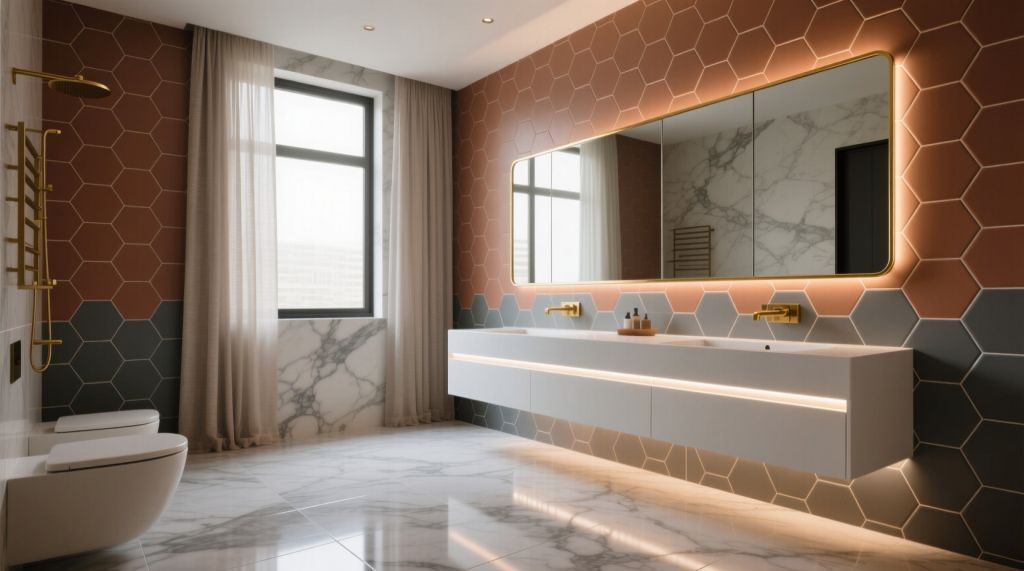
The days of uniform tiled interiors, where every surface mirrored the same safe, monochromatic style, are long gone. Mixing and matching tiles has become a vibrant way to infuse spaces with personality and energy. Whether it’s a kitchen, bathroom, or hallway, a thoughtfully curated combination of tiles can create a modern, dynamic look that feels uniquely personal. The challenge lies in blending patterns, textures, and colors in a way that’s bold yet balanced, ensuring the space feels cohesive rather than chaotic.
The Magic of Harmonious Contrast
A well-executed tile mix captivates with its unity, even when the elements differ. Patterns, colors, or textures may vary, but they should share a subtle connection—a shared tone, finish, or rhythm—that ties them together. This cohesion transforms a space from cluttered to captivating.
Premium tiles make this process more approachable. Their refined craftsmanship and consistent finishes allow for creative combinations without the risk of clashing. For example, pairing a glossy ceramic floor with textured stone wall tiles creates a striking yet cohesive contrast. Visiting a tile shop to explore these pairings in person can reveal how materials interact under real lighting, sparking inspiration for your design.
Define the Atmosphere First
Before diving into tile selections, consider the mood you want to evoke. Are you aiming for a serene, spa-like retreat? A warm, rustic haven? Or a bold, artistic statement? This foundation shapes every choice, from colors to textures to patterns.
For a calming space, choose tiles with gentle contrasts, like soft grey wall tiles paired with creamy marble floors. For a more dramatic effect, opt for opposing hues—deep navy against warm terracotta or black against light stone. Bringing samples of your home’s existing materials—paint swatches, wood finishes, or textiles—to a tile shop can help you test how tiles complement your space. Physical samples offer insights that digital images often miss.
Texture’s Transformative Power
Texture often plays a more significant role than color in creating a compelling tiled space. A room with a single finish can feel one-dimensional, but blending smooth and tactile surfaces adds depth and visual interest.
In a bathroom, large, polished wall tiles paired with smaller, textured floor tiles create a practical yet engaging design—matte surfaces provide better traction in wet areas. In a kitchen, a reflective backsplash alongside a matte floor tile creates a subtle interplay of light and shadow, adding sophistication without overwhelming the space. A tile shop’s displays can inspire ideas for layering textures to achieve a balanced, dynamic look.
Patterns with Purpose
Patterned tiles can make a bold statement, but they shine brightest when used strategically. Select one standout pattern as the focal point and complement it with simpler tiles to maintain balance. For instance, a vibrant geometric floor tile can shine beneath plain wall tiles, or a decorative backsplash can pop against sleek countertops. Moderation is key—two or three tile types per room keep the design focused.
Proportion also matters. Large tiles visually expand a space, while smaller tiles or mosaics add texture and rhythm. Combining them, such as using large floor tiles with a mosaic accent in a shower niche, creates a lively yet cohesive aesthetic. Exploring a tile shop’s room setups can help you visualize how to balance patterns and proportions effectively.
Color as the Foundation
Color anchors the entire tile design. Start with one primary hue to ground the space, then layer in one or two complementary or contrasting shades. Neutral tones like beige or taupe pair beautifully with natural materials like wood or stone, while greys harmonize with blues or whites for a clean, modern feel. Black-and-white combinations are timeless but benefit from warm accents—like wooden shelves or brass fixtures—to avoid feeling stark.
For a bold touch, incorporate rich tones like emerald or amethyst in small areas, such as a feature wall or backsplash. These hues add depth without dominating. A tile shop’s curated color collections can help you find a palette that feels unified and intentional.
Grounding Bold Designs
Even the most striking tile combinations need a grounding element to avoid feeling chaotic. A neutral floor or a plain wall serves as a visual pause, allowing the eye to rest and the statement tiles to shine. Without this balance, a space can feel overly busy.
Think of tile design like music: it needs both rhythm and silence. Neutral or understated tiles provide the calm that highlights vibrant patterns. A tile shop’s displays often showcase how designers use neutral tiles to anchor bold combinations, offering practical inspiration for your project.
Lighting’s Defining Role
Light shapes how tiles perform in a space. Glossy tiles reflect light, making small areas feel brighter and more spacious, while matte tiles absorb light for a softer, cozier atmosphere. When mixing finishes, consider how light moves through the room throughout the day.
In a bright kitchen, too many glossy tiles can create glare, while in a dim bathroom, reflective tiles can enhance brightness. Testing samples under different lighting conditions at a tile shop helps you anticipate how your choices will look in your home.
Quality as the Cornerstone
High-quality tiles are the backbone of a successful mix. Their consistent colors, precise edges, and durable finishes ensure seamless combinations, whether you’re blending tiles from one collection or across brands. A tile shop’s full-room setups can demonstrate how quality materials elevate even the most daring designs, giving you confidence in your choices.
Expressing Your Vision
Mixing tiles is an opportunity to make a space truly your own. Whether you prefer subtle, tonal combinations or vibrant, eclectic pairings, every tile should serve a purpose—adding texture, color, or calm. There’s no universal formula, but intentional choices always lead to a cohesive result.
Final Thoughts
Tiles do more than cover surfaces; they define a room’s character and flow. Mixing them doesn’t have to be intimidating. Focus on quality materials, trust your instincts, and aim for balance. A visit to a tile shop lets you explore textures, see how light interacts with surfaces, and envision how your choices will come together. Bold design isn’t about chaos—it’s about confident, thoughtful decisions that reflect your unique style.


